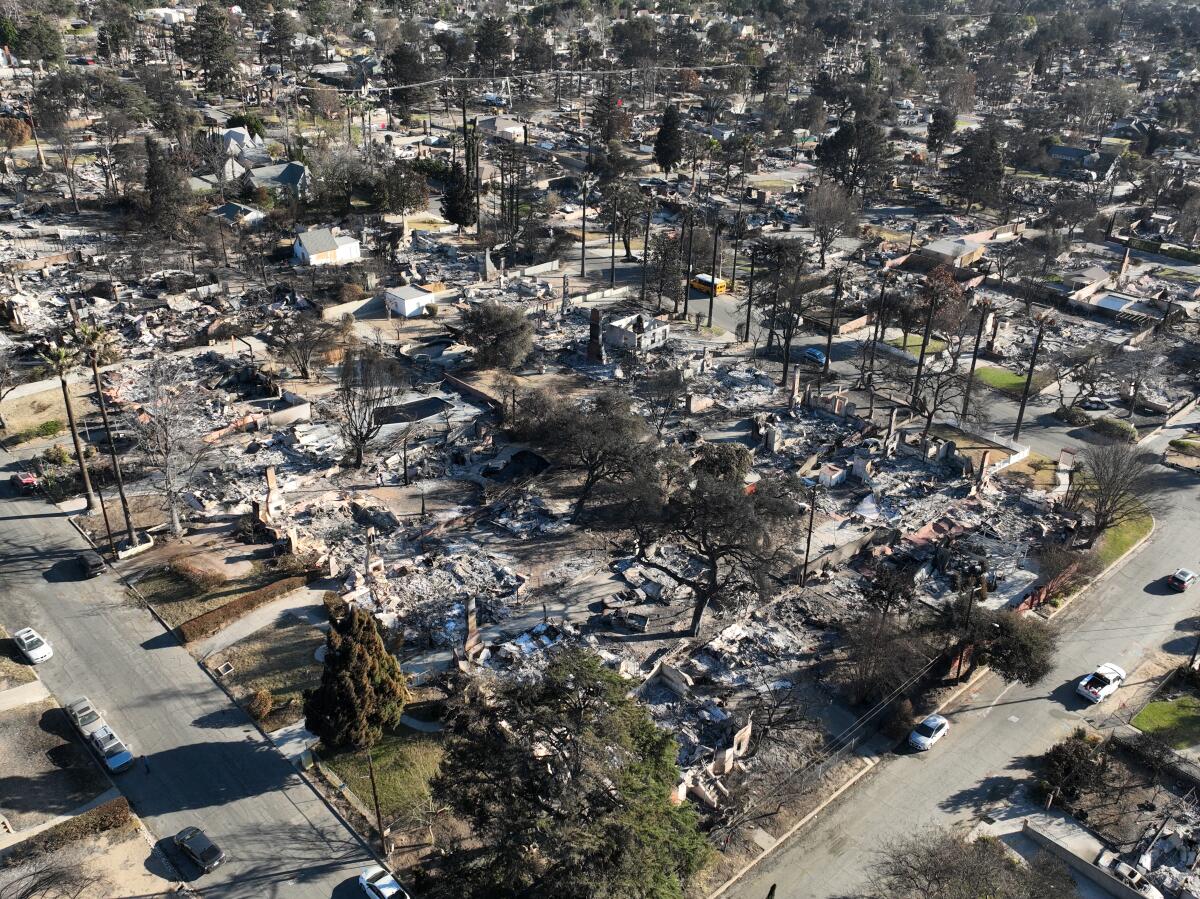Behind the staggering economic toll of the L.A. wildfires

- Share via
- Estimates of the total economic loss from the wildfires have ballooned to more than $250 billion.
- A massive regional recovery effort is underway, which will benefit some sectors while others suffer from displaced workers and customers.
- Countywide, gross domestic product is expected to drop by an estimated $4.6 billion this year.
A disastrous spate of wildfires last month leveled thousands of homes and businesses, changing the course of people’s lives and disrupting the economic balance of major industries across Southern California.
The financial losses are staggering. Estimates of the toll in the Los Angeles region have swelled to more than $250 billion, making it one of the costliest natural disasters in U.S. history.
Countywide, gross domestic product is expected to drop by an estimated $4.6 billion this year, a 0.48% decline, according to a study released last week by UCLA Anderson Forecast. The “astronomical costs,” the study said, include a total wage loss of $297 million for local businesses and employees in the affected areas.
But, as with any natural disaster, be it fire, flood or earthquake, there will be businesses that benefit from the long recovery ahead.
Some small businesses burned down in the Eaton fire. Others are ‘silent casualties’: Intact but out of commission as the community rebuilds.
Among the sectors that stand to gain: construction workers and contractors, environmental and building cleanup firms, real estate agents, owners of short-term rentals, furniture makers and interior designers, retailers selling household goods and hardware, and companies promising to fireproof your home.
On the other side are businesses that were destroyed or damaged by the flames and industries that could suffer from displaced workers and a drop in demand, including tourism and Hollywood production.
“Most disasters have an uneven effect across groups and society,” said Adam Rose, senior research fellow and director emeritus at USC’s Center for Risk and Economic Analysis of Threats and Emergencies. “You’re going to have winners and losers.”
Although the fires will spur a massive regional rebuilding effort, “you don’t want to conclude that disasters are good for the economy,” he said. “As a whole, disasters are a drain.”
Residential and commercial real estate
The wildfires — which burned an estimated 16,000 homes, businesses and other structures — will kick off a massive construction boom around Los Angeles.
The speed and scale will depend on whether city officials “get the hell out of the way and they let these people rebuild, and build faster,” said economist Christopher Thornberg of Beacon Economics, who is advising Steve Soboroff, the city’s chief recovery officer.
The massive blazes have prompted a reckoning on how so many L.A. homes came to be built on land so vulnerable to fire and how, or whether, they should be rebuilt.
In 2008, California significantly strengthened its building code, requiring developers of new homes in high fire-risk areas to use fire-resistant building materials, enclose eaves to stop them from trapping sparks and insert mesh screens over vents to prevent embers from getting into homes.
Although the new building code was a big step forward, some people are making the case for a retreat given the scale of the January fires.
Others have proposed L.A. pause rebuilding to consider stricter construction guidelines, such as mandating even more fire-resistant materials and installing fire shutters on every home.
But rebuilding efforts are fast underway, with Gov. Gavin Newsom and Los Angeles Mayor Karen Bass issuing executive orders to expedite rebuilding by relaxing environmental and regulatory obstacles.
Thornberg estimated that rebuilding will cost an average of about $1 million each per residential property, even in Pacific Palisades where homes were commonly valued at $3 million or more.
Architects, contractors and others in the construction industry are going to profit, especially subcontractors with specialties such as pouring foundations on hillsides, he said.
“These guys are going to make a mint, running like crazy to keep up,” Thornberg said.
That will create a chain reaction, boosting demand for workers and for materials such as steel, wood, concrete, glass and paint, even as the Trump administration’s immigration crackdown and policies on tariffs could complicate those efforts.
Many will use the opportunity to rebuild from the ground up as a way to incorporate modern fire-prevention measures into their plans, said John Schneyer, research director at real estate industry analyst CoreLogic.
As the cleanup phase of recovery begins after the devastating fires in L.A. County, displaced residents grapple with new uncertainty surrounding the cost and timeline for rebuilding.
“Think about risk mitigation on a community level,” he said, which will reduce the chances of another catastrophe and improve insurability of the neighborhood. Noncombustible materials and fireproofing services will be in high demand.
When those properties are completed, real estate agents will be busier than ever. Already, they have been slammed trying to find new homes for displaced families.
“Dozens and dozens of people are going after the same properties,” Compass agent David Berg of Smith & Berg Property Group said. “Our phones have rung hundreds of times.”
If rebuilding goes swiftly, it could boost efforts that were already in the works to construct more housing throughout Los Angeles, Thornberg said, as developers and city officials push for expedited approvals to become the norm.
“This is the silver lining to this very dark cloud,” he said.
Small businesses
The region’s retail sector had just begun to regain its equilibrium after the pandemic and prolonged strikes in Hollywood, when a new chapter of devastation, this one wrought by flames, arrived.
Instead of inching closer to stability, hundreds of small businesses now face a far more dire form of disruption.
The flames were unsparing, at times devouring entire plazas and blocks of small businesses — they charred a McDonald’s and a historic motel, a Gelson’s grocery store and a beloved seafood shack, a Dollar King and a nursery that cultivated rare azaleas.
The corporate chains will endure the losses, although some may choose not to rebuild. But for the mom-and-pop shops in Altadena and the Pacific Palisades — the dry cleaners, tattoo parlors, bars, bistros and stores that sold antiques, flowers, books, pottery and macaroons — the devastation is more personal.
The Trump administration’s plans to slap new tariffs on imports from Canada and other countries could set off new waves of inflation in home building.
Nearly 1,900 small businesses were within the fire burn zones and were probably affected, according to an estimate from the L.A. County Economic Development Corp. Those businesses supported roughly 11,400 jobs, the group said.
Some businesses will never rebuild. Many others have vowed to do so, but face wrenching questions about where they’ll find the money and energy to start over.
The rain will be nothing like the relatively modest storms that have brought largely beneficial rain to Southern California the last two weeks. Forecasters suggest avoiding travel if possible on Thursday.
Even the businesses spared by the flames now face a daunting future, as many of their customers lost their homes — and much of their expendable incomes — overnight. Some will move to new neighborhoods and those who remain will be hesitant to visit the surviving shops surrounded by razed rubble that, in some places, looks like a war zone.
“Who is going to want to come here?” Leo Bulgarini, the owner of an Altadena gelateria that narrowly escaped the Eaton fire, wondered aloud.
In recent weeks, longtime customers posted messages online, thanking the owners of the small businesses that had shaped their communities for decades.
“This is an establishment where the human voice was still alive,” one customer wrote on the GoFundMe page of Oh Happy Day, a vegan cafe in Altadena. The owner had given her free, healthy meals for her mother when she was in the hospital, the customer wrote.
“They brought her back to life. Thank you, John!” she wrote. “You’re an angel.”
On an Instagram post showing a burned Vittorio’s, a longtime Italian staple in the Pacific Palisades, a customer recalled visiting the restaurant with her grandparents as a child and ordering garlic knots.
“This loss is unfathomable.”
Hollywood
The fires are exacerbating an already tough economic climate for L.A.’s most famous industry.
First, it was the shutdown of movie theaters and productions due to COVID-19. Then, it was the dual writers and actors strikes in 2023, which halted projects and delayed film releases, hurting box office revenue. Studios cut back spending, leading to massive layoffs.
There were high hopes for a return to normal business this year. Then the fires hit.
On opposite sides of the region, the Palisades and Eaton fires destroyed homes of Hollywood workers at all levels: actors, directors and producers, crew members and other below-the-line workers.
A number of television productions across Southern California temporarily paused work, including “NCIS,” “Poppa’s House” and “Abbott Elementary.” Famed filming locales, including Will Rogers State Historic Park and the historic Andrew McNally House in Altadena, were destroyed.
The loss comes at a time when Los Angeles has struggled to keep producers from filming out of state, where costs are cheaper.
As Hollywood goes through vast technological, financial and global change, the state’s cornerstone entertainment industry and its workers face a hard reality: Lost jobs may never come back.
With so much up in the air, Hollywood workers fear that the long-awaited production return will be delayed once again.
“The industry in the town is so fragile that every little thing becomes a bigger bump in the road,” producer Kourtney Gleason said.
There could be an upside, though. Some industry insiders believe the economic toll from the fires will pressure lawmakers to approve Newsom’s proposed increase to the California film and TV tax incentive program, which aims to lure production back to the Golden State.
Tourism
The images of billowing clouds of smoke and neighborhoods reduced to rubble detract from the glamorous and beachy image that tourism officials rely on to draw the flocks of visitors who pump billions of dollars into the local economy each year.
The fires struck as tourism in L.A. had just recovered from the blow dealt by the pandemic, and as the city gears up to host the World Cup in 2026 and the Summer Olympics in 2028.
“We’re very nervous,” said Jackie Filla, president and chief executive of the Hotel Assn. of Los Angeles.
Demand for hotel rooms has dropped in downtown L.A., Hollywood and Beverly Hills since the fires began. But it has surged in some fire-adjacent areas as displaced residents search for temporary housing.
In the area that includes Pasadena, Glendale and Burbank, demand for hotel rooms rose 33.6% in the 12 days after the wildfires started. Rates were 9.6% higher than the year before, averaging $179.77, according to a new report by industry analyst CoStar.
After the L.A. fires, many homeowners face a daunting challenge of trying to rebuild and recover generational wealth they have lost.
Despite the devastation in the fire areas, the vast majority of the region’s best-known tourism spots were undamaged. Major conferences, award ceremonies and conventions — a crucial component of the tourism industry — are going on as planned.
Still, some local businesses are already feeling the effects.
At Visit California, the state’s leading tourism organization, Chief Executive Caroline Beteta said she’s hearing from restaurants and hotels that they’re feelings the effects of the historic disaster.
Her team is at work on a recovery campaign stressing that “everyone, especially California residents, should consider planning a trip to Los Angeles to support its economic recovery,” she said.
Overall consumer demand in leisure, hospitality and entertainment spending typically drops in the aftermath of a natural disaster, said Raphaelle Gauvin-Coulombe, an assistant professor of economics at Middlebury in Vermont.
Leisure and hospitality is a sector that is particularly important for L.A. County, amounting to about 13.5% of the workforce, much higher than the median across counties, which hovers around 6%, Gauvin-Coulombe said.
She did note, however, that cities with more diverse economies — such as Los Angeles — tend to be more resilient than those that are heavily dependent on just one sector.
The disaster may also force the industry to contend with a shrinking labor force in the region, with fires tending to cause out-migration, she said. A slowing of employment growth can last for three years after a fire.
Times staff writers Samantha Masunaga, Suhauna Hussain and Christopher Reynolds contributed to this report.
More to Read
Inside the business of entertainment
The Wide Shot brings you news, analysis and insights on everything from streaming wars to production — and what it all means for the future.
You may occasionally receive promotional content from the Los Angeles Times.



















